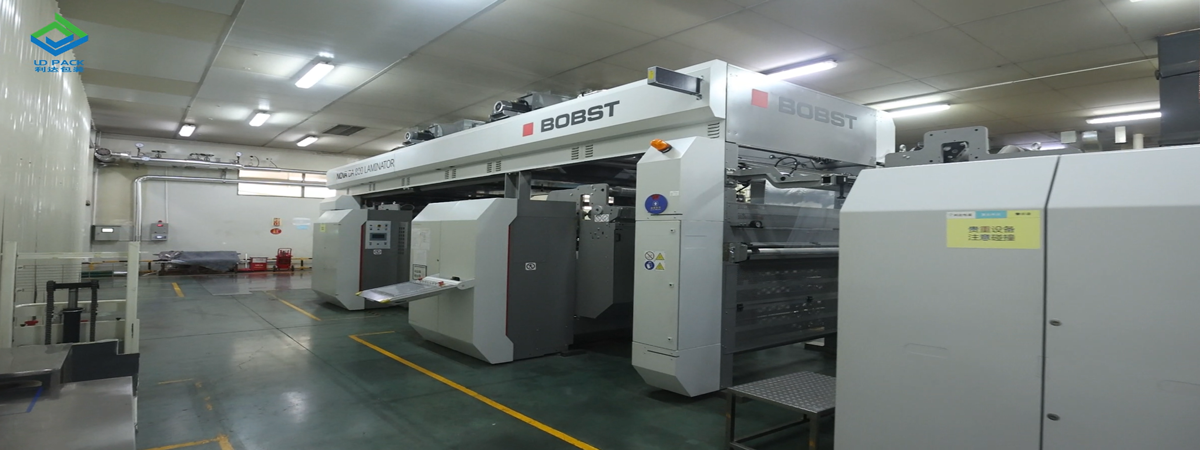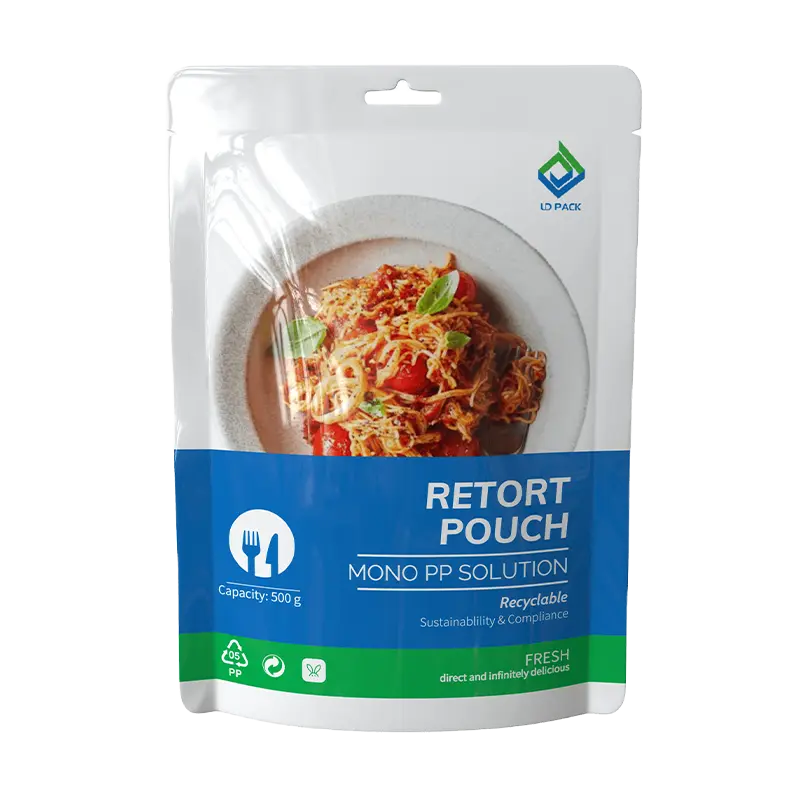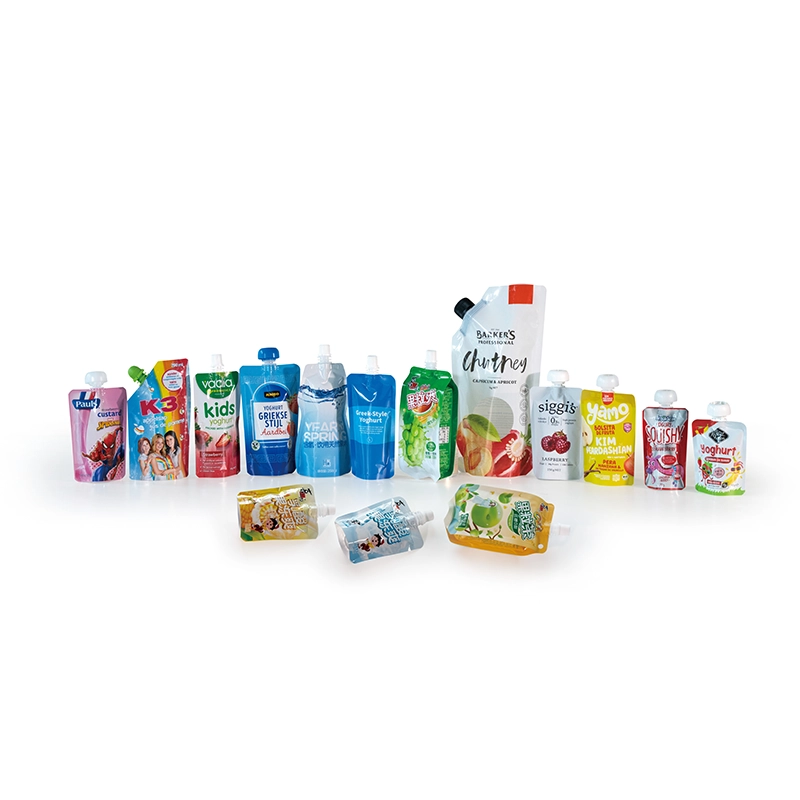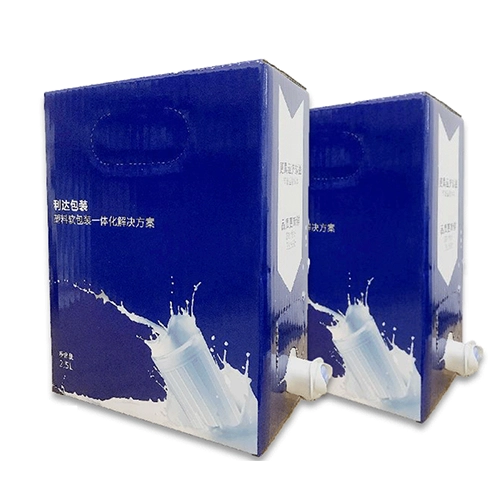Ink Basics
Ink is an essential material used in printing, serving as the substance that forms textual and graphic information during the printing process. It directly determines the tone, color, clarity, and other aspects of the images on the printed product. With the advancement of printing technology, the variety of inks continues to grow, and there are various methods of classification.
LD PACK is an enterprise with over 30 years of experience, utilizing GRAVURE PRINTING, flexographic printing, and digital printing. Each product complies with Chinese and FDA standards, with rigorous supervision starting from the source, including raw materials such as films, inks, solvents, and more.
If classified by printing method, Inks are typically divided into several categories: offset printing ink, GRAVURE PRINTING Ink, flexographic printing Ink, screen printing ink, digital ink, special inks, and more. If classified by drying method, inks are generally categorized as film-forming drying, permeation drying, volatile drying, radiation drying, and other drying types. Due to the different types and ratios of binding agents in the ink, drying is often accomplished through a combination of two or more forms.
For inks used in composite film products, the majority are volatile drying inks, where the binding agent consists of solid resin and a large amount of volatile solvent with low viscosity. The solid resin dissolves in the solvent, uniformly dispersing the pigment in the binding agent. After printing onto the substrate, the solvent rapidly evaporates and dries, forming a film. In printing machines equipped with heating and drying devices, the solvent can quickly evaporate, allowing for printing on non-absorbent substrates such as plastic films.
Currently, plastic films are commonly printed using GRAVURE PRINTING, with some adopting flexographic printing in recent years. GRAVURE PRINTING ink and flexographic printing ink are usually classified into solvent-based ink and water-based ink. This article mainly discusses GRAVURE PRINTING ink and flexographic printing ink.
Ink Properties:
Gravure printing ink is a liquid ink. During gravure printing, the ink relies on its own fluidity, adhesion, filling, and coating on the gravure cylinder's engravings. Only systems with lower viscosity, i.e., relatively thin systems, can exhibit these properties. In a short period, the ink must fill the recesses on the cylinder. If the viscosity is too high, it is challenging to fill the recesses, and the doctor blade will struggle to remove the ink from the non-image areas. On the other hand, if the viscosity is too low, the dot gain caused by the pressure during printing can lead to poor reproduction of the pattern. Additionally, in gravure printing, the doctor blade is used to remove the ink from the non-image areas, causing the remaining ink to return to the original inkwell. Even the ink in the engravings needs to repeatedly contact the original ink. Only fluids with lower viscosity can be easily removed and possess good redissolvability, low tack, and low yield values, adapting well to gravure printing.
Composition of Ink:
Generally, gravure inks consist of four main components: resin, pigment, solvent, and additives. The selection of the resin is usually based on the intended use of the ink. Many properties of the ink, such as abrasion resistance, gloss, and adhesion to the substrate, are determined by the ink's resin. In a sense, the ink's resin determines its major properties. Representative resins commonly used include the following:
Resin Types | Application | Characteristics, Uses, etc. | |||
Gravure | Flexographic | Solvent Ink | Water-based Ink | ||
Rosin and Derivatives | * | * | * | * | Multi-functional rosin esters modified with polyols are widely used as auxiliary resins in various solvent inks. Rosin metal salts are extensively used as the main resin in publication inks. When neutralized, it can be further used in water-based inks. |
Shellac | * | * | * | * | Natural resin, can be used in small quantities as an adhesion aid. |
Alkyd Resin | * | * | - | * | The resin film is permeable and breathable, commonly found in decorative paper applications. |
Nitrocellulose and Cellulose Derivatives | * | * | * | - | Excellent heat resistance. Widely used as a hard resin. Has excellent pigment dispersion properties. |
Polyamide Resin | * | * | * | - | Used for PE, PP films. Usually derived from plant oils such as tung oil, cottonseed oil, soybean oil. Excellent gloss and flexibility. |
Chlorinated Rubber | * | - | * | - | Excellent heat resistance, high gloss. Common in early ink formulations but has fallen out of use due to issues such as odor and high solubility. |
Chlorinated Polypropylene Resin | * | - | * | - | Excellent adhesion on polypropylene materials. |
Chlorinated Polyvinyl Acetate Resin | * | - | * | - | Excellent resistance to chemicals. Excellent pigment affinity. |
Ethylene-Vinyl Acetate Resin | * | - | * | - | Commonly used in inks with 40% vinyl acetate content, very flexible. Sometimes further chlorinated for enhanced solubility and pigment wetting. |
Alcohol Resin (Polyester) | * | * | * | * | Flexible. Generally used as an auxiliary resin to adjust toughness. |
Thermoplastic Polyurethane Resin | * | * | * | - | High molecular design flexibility, the main resin for general-purpose composite inks in flexible packaging. Also used in surface printing inks, often in combination with nitrocellulose. |
Thermoplastic Acrylic Resin | * | * | * | - | Usually used for shrink labels and varnishes. |
Anionic Polyurethane Dispersion | * | * | - | * | Excellent adhesion to PET, nylon, excellent flexibility (especially low-temperature flexibility). Common in food flexible packaging inks or some building materials applications. |
Anionic Polypropylene Acrylic Resin (Emulsion) | * | * | - | * | The main resin for water-based inks, with highly customizable molecular structures, but generally has the drawback of being thermally sticky and brittle. Commonly, a styrene-acrylic copolymer structure is used, with low molecular weight styrene resins used for pigment dispersion and high molecular weight styrene resins used for binding and fixing. |
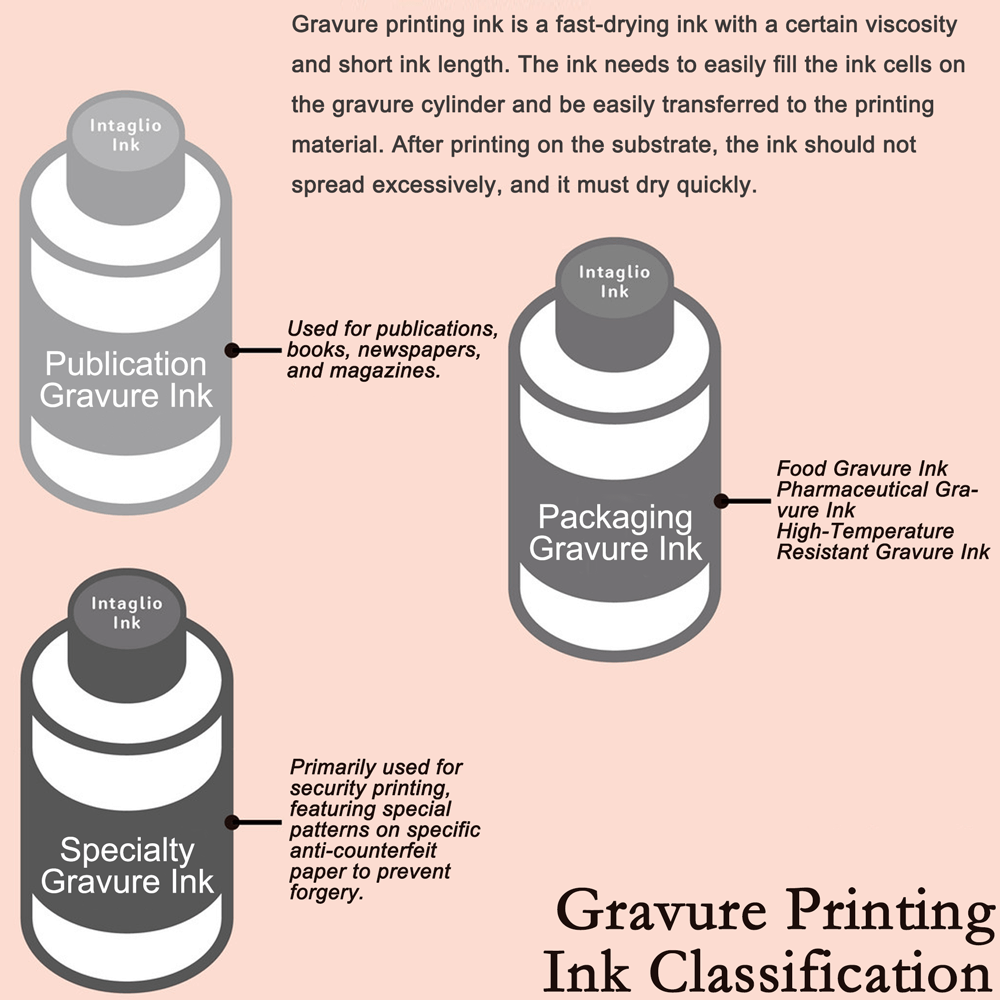
Pigments
The hue, concentration, lightfastness, acid-alkali resistance, and other properties of ink are determined by pigments. Pigments also have a certain influence on the flowability and glossiness of ink. Representative pigment varieties are listed in the table below:
Classification | Typical Examples of Pigments | ||
Organic Pigments | Azo Pigments | lake pigment (Insoluble salt) | Disazo Reds such as PR48:1, PR48:2, PR48:3, PR49:1, PR53:1, PR57:1, etc. |
Monoazo | PY74 Yellow, and Catechol Reds like PR146, PR112, PR170 | ||
Diazo | PY12 Yellow, PY13 Yellow, PY14 Yellow, PY83 Yellow, PO13 Orange, PO34 Orange | ||
Condensation Diazo | PR144 Red, PR166 Red | ||
Phthalocyanines | Phthalo Blue 15:3, 15:4, Copper Phthalocyanine Greens G-7, G-36 | ||
Quinacridones | Quinacridone Red PR122, PV19 Purple | ||
Pyrazoloquinazolines | Pyrazoloquinazoline Red PR254 DPP Red | ||
Quinolines | Quinoline Violet | ||
Other | Benzimidazolone Yellow PY180, Isoindolinone Yellow PY110, Quinoline PY81 Peach Red, PV3, etc. | ||
Inorganic Pigments | Titanium Dioxide | Rutile, Anatase | |
Carbon Black | Furnace Black, Lamp Black, Fast Black, Channel Black, etc. | ||
Other | Barium Sulfate, Calcium Carbonate, Silica | ||
Special Effect Pigments | Silver (Aluminum) Powder, Gold (Copper Zinc) Powder, Pearl Powder, Color-changing | ||
For the final printed product, pigment properties are closely related to durability issues, such as resistance to migration on different packaging materials and contents, heat resistance, chemical resistance, and lightfastness. One of the most common concerns is lightfastness.

Solvents
In gravure inks, the most abundant component is the solvent. Generally, the choice of solvent type is based on the resin selected for the ink, and necessary adjustments are made based on potential issues that may arise during ink usage.
The ideal solvent should be efficient, cost-effective, and harmless. Water is the optimal choice, significantly reducing VOC emissions, preventing air pollution, posing no harm to human health, and being non-combustible. However, water also has several limitations that restrict its use as a solvent. In recent years, there has been some development in using water as a solvent for inks.
In the current industrial system, due to their strong effectiveness and ready availability, organic solvents remain indispensable for high-quality inks. These solvents, after extensive use and screening, mainly include benzene, ketones, alcohols, ethers, and coolants. In recent years, the use of benzene and ketones has been restricted due to safety and health concerns. Because of the need for volatility, the boiling point of flexographic and gravure inks is lower, typically in the range of 70 to 150°C, while inkjet inks have a higher boiling point, usually in the range of 150 to 260°C.
Solvent | Solvent Name | Boiling Point*1 at 760 mmHg | Flash Point*1 | Surface Tension*1 (Dyn/cm) | Solubility Parameter*2 | Vaporization Rate*3 |
Water | 100.0 | - | 72.0 | 23.2 | 40 | |
Aliphatic Hydrocarbons | N-Heptane O-Cyclohexane Methylcyclohexane Toluene Xylene | 68.7 80.719 100.934 110.625 139 ~ 142 | <-23.℃ -17.℃ -1.℃ 4.4.℃ 17~25.℃ | 17.9 24.38(25℃) 23.17(25℃) 27.92(25℃) 28~30 | 7.3 8.2 7.8 8.9 8.8 | - - - 205 70 |
Esters | Ethyl Acetate Isopropyl Acetate Butyl Acetate Butyl Acetate Butyl Acetate | 77.114 89 101.55 118.0 126.114 | -4℃ 4.44℃ 14.4℃ 17.8℃ 27.℃ | 23.75 22.1(22℃) 24.28(20℃) 23.7(20℃) 25.09(20℃) | 9.1 8.4 8.8 8.3 8.5 | 615 500 276 145 100 |
Ketones | Acetone Methyl Ethyl Ketone (MEK) Methyl Isobutyl Ketone (MIBK) | 56.12 79.64 115.9 | -17.8℃ -7.2℃ 15.6℃ | 23.7 23.97(24.8℃) 25.4(25℃) | 10.0 9.3 8.4 | 1160 572 160 |
Alcohols | Methanol Ethanol Isopropanol N-Propanol Isobutanol N-Butanol | 64.6 78.3 82.4 97.2 107.9 117.5 | 12.℃ 14.℃ 11.7℃ (27.℃ ) (27.5℃) 35.℃ | 22.55(20℃) 22.1(25℃) 21.7(20℃) 23.8(20℃) 23.0(20℃) 24.6(20℃) | 14.5 12.7 11.5 11.9 11.1 11.4 | 200 190 150 100 70 50 |
Polyols | Propylene Glycol Methyl Ether Dipropylene Glycol Methyl Ether Dipropylene Glycol Ethyl Ether Dipropylene Glycol Butyl Ether | 120.0 194.1 202.0 230.4 | (39.℃) (93.℃) (96.℃ ) (93.℃) | 27.1(20℃) 34.8(25℃ ) 31.8(25℃) 33.6(25℃ ) | 9.5 10.2 9.6 8.9 | 71 <1 <1 <1 |
Evaporation Rate: Determined value in an open system with n-butyl acetate set as 100. (℃)
*1 Solvent Handbook 6th Edition, by Shozo Asahara (1985)
*2 Shell BLENDOPRO 4.0 User Manual, unit: [cal/cm;]1/2
*3 Paint Overview 4th Edition, Paint Overview Editorial Committee (1971)
Here, the properties of water appear vastly different compared to other solvents. From a molecular perspective, the molecular weight of water (H2O) is only 18, and it has a high polarity, making it inherently a very active substance. However, there are strong hydrogen bonds between water molecules, akin to magnets, which tightly cluster the liquid water together. In fact, the water molecules change from H2O to (H2O), meaning that the water molecules become larger and more cumbersome.
This is the fundamental reason for the unique properties of water. Specifically, it exhibits:
Evaporation requires a significant amount of heat absorption: Water's latent heat of vaporization is 539 (cal/g), whereas typical ethanol is 204 (cal/g), and butyl acetate is 74 (cal/g). The latent heat of vaporization for water is several times that of other commonly used solvents.
Drying is slow: The evaporation rate is approximately 1/5 that of ethanol and 2/5 that of butyl acetate.
Poor wetting ability: Applications on low-polarity substrates encounter significant difficulties, and additives to solve this problem often have side effects and face VOC restrictions.
Additionally, water has poor lubricity, which affects the suitability of the doctor blade, thereby impacting the lifespan of the plate roller or anilox roller.
Considering all these aspects comprehensively, using water as a solvent is undoubtedly a challenging task.
Additives
While pigment powders, resins, and solvents form the basic structure of ink, it is still necessary to customize the ink according to its intended use and customer requirements.
Classification | Purpose of Use Main | Components |
Pigment Dispersants | Improve pigment dispersion Prevent settling Enhance storage stability | Specific low-molecular-weight or high-molecular-weight agents with a particular structure, pigment derivatives |
Defoamers | Inhibit ink bubbles Prevent film defects on printed material | Silicon, mineral oil, higher alcohols |
Wetting and Leveling | Agents Promote ink spreading and leveling on substrates | Surfactants, low surface tension solvents such as alcohol ethers |
Slip Agents | Enhance friction resistance, scratch resistance, adhesion | Synthetic wax, natural wax, silicon, fatty acids |
Curing Agents | Improve water resistance, heat resistance, chemical resistance, increase composite strength, enhance adhesion | Isocyanates Epoxy curing agents Metal ions and compounds |
Plasticizers | Enhance flexibility and adhesion of the coating, improve film-forming properties of resins, prevent whitening | Citric acid, (poly)alcohols, epoxy soybean oil, etc. |
Ink Manufacturing Process
The various components of ink must be mixed in an appropriate manner. When the pigments are non-agglomerative special pigments, typically high-speed stirring is sufficient for mixing. However, when the pigments are agglomerative, high-energy milling equipment must be used for refinement. The typical ink manufacturing process includes the following steps:
1. Formulation and premixing, usually done using a mixer.
2. Grinding: Using shear and impact forces to pulverize materials, commonly done with a bead mill.
3. Adjustment: Tuning ink properties to ensure physical characteristics.
4. Filtration, filling, packaging, inspection, and storage.
The most crucial step is grinding, where a bead mill utilizing high-density beads for impact and shear is widely used in liquid inks. Due to the high volatility of solvent-based inks, a closed bead mill is typically employed. In general, advanced equipment and operational processes are equally important for the final result.
Mixer: Mixing of materials and pre-dispersion.
Bead Mill: Dispersion of medium to low viscosity materials (collision and shear with high-density media, closed operation, widely used).
Bead milling is the process of finely grinding pigment particles and achieving complete resin encapsulation. The fineness and temperature must be appropriate, and the fineness index of the ink when it leaves the factory is generally the maximum particle size.
Ink Properties and Specifications
After the production of ink is complete, multiple factory indicators are tested. However, as part of ink design itself, various design indicators must be considered and calibrated during the formulation design. The table below provides some examples:
Experiment | Quality Items |
Ink Appearance | Grindability (dispersibility), viscosity, fluidity, color tone, gloss, specific gravity, solid content, pH value, storage stability, etc. |
Printing Suitability | Blade adaptability, blocking performance, dot reproduction, drying properties, redissolvability, defoaming properties, on-press stability, cleanability, etc. |
Coating Properties | Friction resistance, heat resistance, adhesion, scratch resistance, anti-adhesion, chemical resistance, light resistance, water repellency, residual solvents, slipperiness, etc. |
Post-Processing | Properties Friction resistance, heat adhesiveness, heat sealing suitability, compatibility with lamination, etc |
These indicators require specialized equipment, most of which are well-known. Furthermore, we need to consider unconventional constraints based on the legal regulations applicable to the final use, such as heavy metals, aromatic amines, plasticizers, specific VOCs, etc. These constraints need to be addressed in the formulation design stage, and final testing is just for verification. Excellent quality relies more on design than inspection. This statement is particularly applicable in the ink industry.
